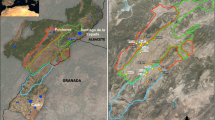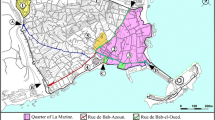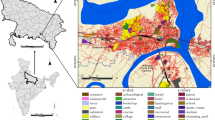Abstract
For the first Americans to establish territories in the New World, the concept of remoteness must have differed considerably from later periods. The Middle Susitna Valley of south-central Alaska was sparsely occupied during the late Pleistocene and underwent millenia of marginal exploration by the earliest Alaskans prior to becoming fully colonized in the early Holocene. For most of prehistory the Susitna Valley was socially and economically “remote.” Disequilibrium dynamics likely influenced cultural adaptations in the Middle Susitna Valley, ultimately transforming a geographically remote location into a familiar place through experience. Reduced remoteness is manifested in cultural traditions that include trails, place names, material culture, and religious beliefs. In the case of the Middle Susitna region its remote position facilitated the maintenance of band level society political organization adjacent to developing social complexity along the coast.



Similar content being viewed by others
References
Ager, T. A. (1983). Holocene vegetation history of Alaska. In Wright Jr., H. (ed), Late Quaternary Environments of the United States, The Holocene Vol 2, University of Minnesota Press, pp. 128–141
Anderson, P. M., Brubaker, L. B. (1993). Holocene vegetation and climate histories of Alaska. Global climates since the last glacial maximum. In Wright Jr, H. E., Kutzback, J. E., Webb III, T., Ruddiman, W. F., Street-Perrott, F. A., Bartlein, P. J. (eds), Global Climates since the Last Glacial Maximum, University of Minnesota Press, pp. 385–400
Armstrong, R. H. (2008). Guide to the birds of Alaska. Graphic Arts Center Publishing Company.
Arnold, J. E. (1996). The Archaeology of Complex Hunter-Gatherers. Journal of Archaeological Method and Theory 3: 77–126.
Bacon, G. H., Kari, J. M., and Cole, T. M. (1983). Cultural Resources Assessment: Talkeetna-Lower Susitna River Basin, Southcentral Alaska Report, U.S. Department of Agriculture, Soil Conservation Service, Alaskarctic, Anchorage.
Bagg, J. S. (1900). A trip up the Chicaloon. In Compilation of Narratives of the Exploration of Alaska. United States Government Printing Office, pp. 682–684
Barlindhaug, S., and Corbett, J. (2014). Living a Long Way from Home: Communicating Land-Related Knowledge in Dispersed Indigenous Communities, an Alternative Approach. Acta Borealia 31: 1–24.
Barrett, B. M. (1974). An Assessment of the Anadromous Fish Populations in the Upper Susitna River Watershed Between Devil Canyon and the Chulitna River. Alaska Department of Fish and Game, Anchorage. APA document 1612.
Barton, C. M., Schmich, S., James, S. R. (2004). The ecology of human colonization in pristine landscapes. In Barton, C. M., Clark, G. A., Yesner, D. R., and Pearson, G.A., (eds.), The Settlement of the American Continents. The University of Arizona Press, pp. 138–161
Basso, K. H. (1996). Wisdom Sits in Places: Landscape and Language Among the Western Apache. University of New Mexico Press.
Begét, J. E., Reger, R. D., Pinney, D., Gillispie, T., and Campbell, K. (1991). Correlation of the Holocene Jarvis Creek, Tangle Lakes, Cantwell and Hayes tephras in Southcentral and Central Alaska. Quaternary Research 35: 174–189.
Betts, R. C. (1987). Archeological Investigations at Butte Lake, Alaska: A Report to the University of Alaska Museum Geist Fund, Report on file at the Alaska Office of History and Archeology, Anchorage.
Binford, L. (1980). Willow smoke and dogs’ tails: hunter-gatherer settlement systems and archaeological site formation. American Antiquity 45: 4–20.
Bocco, G. (2016). Remoteness and remote places. A geographic perspective. Geoforum 77: 178–181.
Boraas, A. S. (2007). Dena’ina Prehistory. In Gaul, K. (ed.), Nanutset ch'u Q'udi Gu (Before Our Time and Now): An Ethnohistory of Lake Clark National Park. National Park Service, pp. 31–40
Boraas, A. S., and Peter, D. (2008). The role of Beggesh and Beggesha in precontact Dena’ina culture. Alaska Journal of Anthropology 6: 211–224.
Brody, H. (1982). Maps and Dreams: Indians and the British Columbia Frontier. Norman and Hobhouse.
Brown, G. (2002). Wilderness in Alaska. Is it exceptional? International Journal of Wilderness 8: 14–18.
Brubaker, L. B., Anderson, P. M., Edwards, M. E., and Lozhkin, A. V. (2005). Beringia as a glacial refugium for boreal trees and shrubs: new perspectives from mapped pollen data. Journal of Biogeography 32: 833–848.
Castner, J.C. Lieutenant, 4th infantry. (1984). Lieutenant Castner’s Alaskan Exploration, 1898: A Journey of Hardship and Suffering. Alaska Historical Commissions Studies in History No. 125. Cook Inlet Historical Society.
Clark, D. W. (1991). Western Subarctic Prehistory, Canadian Museum of Civilization, Quebec.
Cooper, H. K. (2006). Copper and social complexity: Frederica de Laguna’s contribution to our understanding of the role of metals in Native Alaskan society. Arctic Anthropology 43: 148–163.
Cooper, H. K. (2011). The life (lives) and times of Native copper in northwest North America. World Archaeology 43: 252–270.
Cooper, H. K. (2012). Innovation and prestige among northern hunter-gatherers: Late prehistoric Native copper use in Alaska and Yukon. American Antiquity 77: 565–590.
De Laguna, F. (1969). The Ahtna of the Copper River, Alaska: The World of Men and Animals. Folk 11: 17–26.
De Laguna F, McClellan C. (1981). Ahtna. Pages 641–643 in Helm J, ed. Handbook of North American Indians, Volume 6: The Subarctic. The Smithsonian Institution.
Des Lauriers M, Duke D. (2014). Lonesome Landscapes: The Archaeology of Remoteness and Isolation. Society for American Archaeology Session Abstract.
Dixon, E. J., Smith, G. S. (1990). A regional application of tephrochronology in Alaska. In Lasca, N. P., and Donahue, J. (eds.), Archaeological Geology of North America. Geological Society of America, Centennial Special Volume 4, pp. 383–398
Dixon, R.G. (1996). Tiq'atl'ena Bena (Hewitt Lake) Archaeological Research Project, 1992 Investigations. In Davis, N.Y., and Davis, W.E. (eds.), Adventures through Time, Readings in the Anthropology of Cook Inlet, Alaska. Cook Inlet Historical Society, pp. 93–108
Elston, R., Brantingham, P. J. (2002). Microlithic technology in northern Asia: a risk-minimizing strategy of the late Paleolithic and early Holocene. In Elston, R., Kuhn, S., (eds.), Thinking Small: Global Perspectives on Microlithization. Anthropological Papers of the American Anthropological Association. No. 12, pp. 103–116
Esdale, J. A. (2008). A current synthesis of the Northern Archaic. Arctic Anthropology 45: 3–38.
Fall, J. A. (1981). Patterns of Upper Inlet Tanaina Leadership, 1741-1918. PhD dissertation. University of Wisconsin-Madison.
Finney, B. P., Gregory-Eaves, I., Douglas, M. S., and Smol, J. P. (2002). Fisheries productivity in the northeastern Pacific Ocean over the past 2,200 years. Nature 416: 729–733.
Fitzhugh, W. (1997). Biogeographical archaeology in the eastern North American arctic. Human Ecology 25: 385–418.
Fitzhugh, W. (2003). Evolution of Complex Hunter-Gatherers. Kluwer-Plenum.
Gallant, A. L., Binnian, E. F., Omernik, J. M., Shasby, M. B. (1995). Ecoregions of Alaska. United States Geological Survey Professional Paper 1567. US Government Printing Office.
Golledge, R. G. (2003). Human wayfinding and cognitive maps. In Rockman, M., and Steele, J. (eds.), Colonization of Unfamiliar Landscapes, The Archaeology of Adaptation, Routledge, pp. 25–43.
Graf, K. E., and Bigelow, N. (2011). Human response to climate during the Younger Dryas chronozone in Central Alaska. Quaternary International 242: 434–451.
Hamilton, T. D., Thorson, R. M. (1983). The Cordilleran ice sheet in Alaska. In Porter, S. C. (ed.), Late-Quaternary Environments of the United States. University of Minnesota Press, pp. 38–52
Hayden, B. (1995). Pathways to power. In Price, T. D., Feinman, G. M., (ed.), Foundations of Social Inequality. Springer, pp. 15–86
Holtham, A. J., Gregory-Eaves, I., Pellatt, M. G., Selbie, D. T., Stewart, L., Finney, B. P., and Smol, J. P. (2004). The influence of flushing rates, terrestrial input and low salmon escapement densities on paleolimnological reconstructions of sockeye salmon (Oncorhynchus nerka) nutrient dynamics in Alaska and British Columbia. Journal of Paleolimnology 32: 255–271.
Hu, F. S., Finney, B. F., and Brubaker, L. B. (2001). Effects of Holocene Alnus expansion on aquatic productivity, nitrogen cycling, and soil development in southwestern Alaska. Ecosystems 4: 358–368.
Huskey, L., and Morehouse, T. A. (1992). Development in remote regions: what do we know? Arctic (2): 128–137.
Jordan, P. (2015). Technology as human social tradition: cultural transmission among hunter-gatherers. University of California Press.
Kari, J. (1986). Tatl’ahwtaenn Nenn’, The Headwaters People’s Country. Alaska Native Language Center.
Kari, J. (1989). Some linguistic insights into Dena’ina prehistory. In Cook ED., Rice KD. (eds.), Athapaskan Linguistics: Current Perspectives on a Language Family. Mouton de Gruyter. pp 533–574
Kari, J. (2010a). Ahtna Travel Narratives: A Demonstration of Shared Geographic Knowledge among Alaskan Athabascans. Alaska Native Language Center.
Kari, J. (2010b). The concept of geolinguistic conservatism in Na-Dene prehistory. In Kari, J., and Potter, B. (eds.), The Dene-Yeniseian Connection, Anthropological Papers of the University of Alaska. New Series 5:194–222.
Kari, J., Fall, J. A., eds. (2003). Shem Pete's Alaska: The Territory of the Upper Cook Inlet Dena'ina. 2nd edition. University of Alaska Press.
Kelly, R. L. (1995). The Foraging Spectrum: Diversity in Hunter-Gatherer Lifeways. Smithsonian Institution Press.
Kelly, R. L. (2003). Colonization of new land by hunter-gatherers: expectations and implications based on ethnographic data. In Rockkman, M., and Steele, J. (eds.), Colonization of Unfamiliar Landscapes, The Archaeology of Adaptation, Routledge, pp. 44–58.
Kelly, R. L., and Todd, L. C. (1988). Coming into the country: early Paleoindian hunting and mobility. American Antiquity 53: 231–244.
Krasinski, K. E., Wygal, B. T., Wells, J., Martin, R., and Seager-Boss, F. (2016). Detecting Late Holocene Cultural Landscape Modifications in the Susitna Valley, Southcentral Alaska, Boreal Forest with LiDAR Imagery. Journal of Field Archaeology 41(3): 255–270.
Krasinski, K. E., and Haynes, G. (2010). Eastern Beringian Quaternary extinctions: chronology, climate, and people. Alaska Journal of Anthropology 8: 43–64.
Krasinski, K. E., Wygal, B. T., Seager-Boss, F. (2013). Middle Susitna Valley Archeological Survey and Inventory Report for Project Years 2011–2013. Alaska State Historic Preservation Office.
Langdon, S. J. (1994). The Native People of Alaska: Traditional Living in a Northern Land. Greatland Graphics.
Leggett, A. (2013). “The Ones Who Caused Us a Bad Time”: Dena’ina shaman wars during the late eighteenth century. Paper presented to the 40th Annual Alaska Anthropological Association; 13–16 March, Anchorage.
Mann, D. H., Crowell, A. L., Hamilton, T. D., and Finney, B. P. (1998). Holocene geologic and climatic history around the Gulf of Alaska. Arctic Anthropology 35: 112–131.
Mason, O. K. (1998). The contest between Ipiutak, Old Bering Sea, and Birnirk Polities and the origin of whaling during the first millennium A.D. along Bering Strait. Journal of Anthropological Archaeology 17: 240–325.
McKennan, R. (1959). The Upper Tanana Indians. Publications in Anthropology 55. Yale University Press.
Nelson, R. K. (1983). The Athabaskans: People of the Boreal Forest. Alaska Historical Commission Studies in History No. 27. University of Alaska Museum.
Osgood, C. (1936). The Distribution of the Northern Athapaskan Indians. Publications in Anthropology 7:3–23. Yale University Press.
Osgood, C. (1937). The Ethnography of the Tanaina. Yale University Department of Anthropology Publications, Number 16.
Potter, B. A. (2011). Late Pleistocene and early Holocene assemblage variability in Central Alaska. In Goevel, T., and Buvit, I. (eds.), From the Yenisei to the Yukon: Interpreting Lithic Assemblage Variability in Late Pleistocene/Early Holocene Beringia, Center for the Study of the First Americans Series, Texas A&M Press, pp. 215–233.
Potter, B. A., Irish, J. D., Reuther, J. D., Gelvin-Reymiller, C., and Holliday, V. T. (2011). A Terminal Pleistocene Child Cremation and Residential Structure from Eastern Beringia. Science 331(6020): 1058–1062.
Rasic, J. T. (2011). Functional variability in the late Pleistocene archeological record of Eastern Beringia: a model of late Pleistocene land use and technology from Northwest Alaska. In Goebel, T., and Buvit, I. (eds.), From the Yenisei to the Yukon: Interpreting Lithic Assemblage Variability in Late Pleistocene/Early Holocene Beringia, Center for the Study of the First Americans Series, Texas A&M Press, pp. 128–164.
Reger, D. (1998). Archeology of the northern Kenai Peninsula and Upper Cook Inlet. Arctic Anthropology 35: 160–171.
Reger, D. R., and Bacon, G. (1996). Long Lake. In West, F. H. (ed.), American Beginnings, The Prehistory and Paleoecology of Beringia, University of Chicago Press, pp. 436–438.
Reger, D. R., and Boraas, A. (1996). An overview of the radiocarbon chronology in Cook Inlet prehistory. In Davis, N. Y., and Davis, W. E. (eds.), Adventures through Time, Readings in the Anthropology of Cook Inlet, Cook Inlet Historical Society, pp. 155–172.
Ricketts, T. H., Dinerstein, E., Olson, D. M., Loucks, C. J., Eichbaum, W., DellaSalla, D., Kavanagh, K., Hedao, P., Hurley, P., Carney, K., Abell, R., Walters, S. (1999). Terrestrial ecoregions of North America A conservation assessment. Washington D.C. Island Press.
Riede, F. (2005). To Boldly Go Where No (Hu-)Man Has Gone Before.’ Some thoughts on the pioneer colonisations of pristine landscapes. Archaeological Review from Cambridge 20: 20–38.
Riede, F. (2007). ‘Stretched thin, like butter on too much bread…’: some thoughts about journeying in the unfamiliar landscapes of late Palaeolithic Southern Scandinavia. In Johnson, R., Cummings, V. (eds.), Prehistoric Journeys. Oxbow, pp. 8–20
Riede, F. (2014). Success and failure during the Late Glacial pioneer human re-colonisation of southern Scandinavia. In Riede, F., and Tallavaara, M. (eds.), Lateglacial and Postglacial Pioneers in Northern Europe, British Archaeological Reports (International Series) 2599, Archaeopress, pp. 33–52.
Riehle, J. R., Bowers, P. M., and Ager, T. A. (1990). The Hayes tephra deposits, an upper Holocene marker horizon in Southcentral Alaska. Quaternary Research 33: 276–290.
Rockman, M. (2003). Knowledge and learning in the archaeology of colonization. In Rockman, M., and Steele, J. (eds.), Colonisation of Unfamiliar Landscapes, The Archaeology of Adaptation, Routledge, London, pp. 3–24.
Rockman, M. (2009). Landscape learning in relation to evolutionary theory. In Prentiss, A. M., Kuijit, I., and Chatters, J. C. (eds.), Macroevolution in Human Prehistory, Springer, New York, pp. 51–72.
Schoephorster, D. B., Hinton, R. B. (1973). Soil Survey, Susitna Valley Area Alaska. United States Department of Agriculture Soil Conservation Service. U.S. Government Printing Office.
Seager-Boss, F. (1996). Survey and Inventory of Chief Wasilla House Site. Matanuska-Susitna Borough.
Seager-Boss F. (2004). Coastal Zone Management: Middle Susitna Archeological Survey and Inventory. Matanuska-Susitna Borough.
Solovjova, K., and Vovnyanko, A. (1999). The rise and decline of the Lebedev-Lastochkin company: Russian colonization of South Central Alaska, 1787-1798. The Pacific Northwest Quarterly 90: 191–205.
Tikhemenev, P. A. (1978). A History of the Russian American Company. In Pierce, R. A., Donnally, A. S., (eds.), University of Washington Press.
Townsend, J. B. (1980). Ranked societies of the Alaskan Pacific Rim. Senri Ethnological Studies 4: 123–156.
Uchiyama, T., Finney, B. P., and Adkison, M. D. (2008). Effects of marine-derived nutrients on population dynamics of sockeye salmon (Oncorhynchus nerka). Canadian Journal of Fisheries and Aquatic Sciences 65: 1635–1648.
VanStone, J. W. (1974). Athapaskan Adaptations: Hunters and Fishermen of the Subarctic Forests. Aldine.
Viereck, L. A., Dyrness, C. T., Batten, A. R., Wenzlick, K. J. (1992). The Alaska Vegetation Classification. U.S. Department of Agriculture.
West, F. H. (1965). Excavations at Two Sites on the Teklanika River, Mount McKinley National Park, Alaska. National Park Service and University of Alaska Report.
West, F. H. (1967). The Donnelly Ridge site and the definition of an early core and blade complex in Central Alaska. American Antiquity 32: 360–382.
West, F. H. (1975). Dating the Denali Complex. Arctic Anthropology 12: 76–81.
West, F. H. (1981) The Archaeology of Beringia. Columbia University Press.
West, F. H. (1996). American Beginnings: The Prehistory and Paleoecology of Beringia, ed. University of Chicago Press.
Willerslev, R. (2007). Soul hunters: hunting, animism, and personhood among the Siberian Yukaghirs. University of California Press.
Winterhalder, B. (1980). Environmental analysis in human evolution and adaptation research. Human Ecology 8: 135–170.
Workman, W. B. (1976). Archeological Investigations at GUL 077: A Prehistoric Site Near Gulkana, Alaska, Alaska Methodist University. MS on file at the Office of History and Archaeology, State of Alaska, Anchorage.
Workman, W. B. (1979). The significance of volcanism in the prehistory of subarctic northwest North America. In Sheets, P. D., Grayson, D. K. (eds.), Volcanic Activity and Human Ecology. Academic Press, pp. 339–371
Worthington, A., Bowden, S. (1996). A Guide to Dena’ina House Depressions at Kijik National Historic Landmark. Department of the Interior, National Park Service, Alaska System Support Office.
Wygal, B. (2009). Prehistoric Colonization of Southcentral Alaska: Human Adaptations in a Post Glacial World, Dissertation, University of Nevada, Reno.
Wygal, BT. (2010). Prehistoric upland tool production in the Central Alaska Range. Alaska Journal of Anthropology 8: 107–120.
Wygal, B. (2011). The microblade/non-microblade dichotomy: climatic implications, toolkit variability and the role of tiny tools in Eastern Beringia. In Goebel, T., and Buvit, I. (eds.), From the Yenisei to the Yukon: Interpreting Lithic Assemblage Variability in Late Pleistocene/Early Holocene Beringia, Center for the Study of the First Americans Series, Texas A&M Press, pp. 234–254.
Wygal, B. T., and Goebel, T. (2012). Early prehistoric archeology of the Middle Susitna Valley, Alaska. Arctic Anthropology 49: 45–67.
Yesner, D. R. (1989). Moose hunters of the boreal forest? A re-examination of subsistence patterns in the Western Subarctic. Arctic 42: 97–108.
Zedeño, M. N., and Stoffle, R. W. (2003). Tracking the role of pathways in the evolution of a human landscape. In Rockman, M., and Steele, J. (eds.), Colonization of Unfamiliar Landscapes, The Archaeology of Adaptation, Routledge, pp. 59–80.
Acknowledgements
I thank Felix Riede and Arctic Research Center, Aarhus University for inviting this contribution to their special issue. I also thank Daron Duke, Matthew Des Lauriers, Brian Wygal, and three anonymous reviewers for thought-provoking ideas that improved the quality of this paper.
Funding
Fieldwork which formed the basis of this analysis was funded by Adelphi University, Matanuska-Susitna Borough, and a Coastal Management Zone grant (2004).
Author information
Authors and Affiliations
Corresponding author
Ethics declarations
Conflict of Interest
The author declares there is no conflict of interest.
Informed Consent
Human subjects were not used in this research.
Rights and permissions
About this article
Cite this article
Krasinski, K. Archaeological Concepts of Remoteness and Land-Use in Prehistoric Alaska. Hum Ecol 46, 651–663 (2018). https://doi.org/10.1007/s10745-018-9987-9
Published:
Issue Date:
DOI: https://doi.org/10.1007/s10745-018-9987-9




